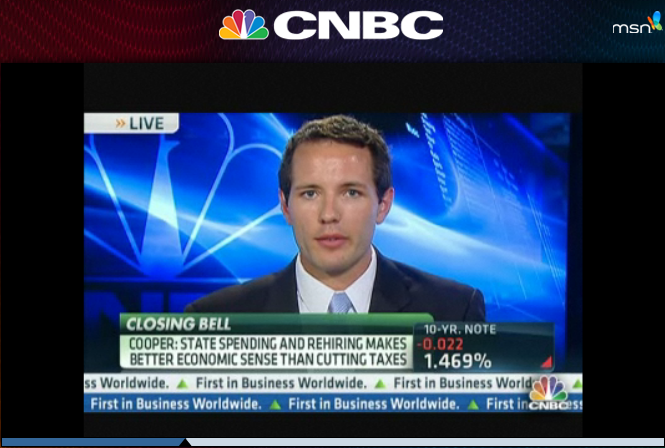With the Bush-era tax cuts set to expire at the end of 2012, the Obama administration has pushed to extend the tax cuts for all but the top 2 percent of filers. One under-examined feature of the cuts is their disproportionate cut in tax rates on income derived from wealth. Currently, most long-term capital gains and dividends face a top rate of 15 percent, much lower than the overall top marginal rate applied to wages and salaries.This increasingly benefits the wealthiest filers. 
As this week’s Economic Snapshot depicts, between 1996 and 2006, top filers earned a growing share of their before-tax income from capital gains and dividends and a declining share from wages and salaries. Filers in the top 0.1 percent of the distribution and the top 1.0 percent of the distribution experienced a 6.1 and 7.4 percentage-point increase, respectively, in their share of income from capital gains and dividends. The bottom 80 percent of filers, on the other hand, experienced virtually no change in their share of income from wages and salaries and actually saw a decrease in their share of income from capital gains and dividends.
Inequality, exhibit A: Walmart and the wealth of American families
The last month has seen both the 50th anniversary of the opening of the first Walmart and the release of Federal Reserve data on family wealth from the Survey of Consumer Finances (SCF). The report showed the median wealth of American families fell by 38.8 percent between 2007 and 2010. In “Inequality, exhibit A: Walmart and the wealth of American families,” EPI Research and Policy Director Josh Bivens drew attention to the growing disparity between the wealth the typical family holds and the staggering wealth of the nation’s richest families. “In 2010, as the Waltons’ wealth has risen and most other Americans’ wealth declined, it is now the case that the Walton family wealth is as large as the bottom 48.8 million families in the wealth distribution (constituting 41.5 percent of all American families) combined,” wrote Bivens.
Media outlets, including the Huffington Post and the Los Angeles Times, have cited Bivens’s article to reveal just how drastic economic inequality has become.
- From the Huffington Post: “The six heirs to the Walmart fortune are worth as much as nearly half of all American households. The Walton family was worth $89.5 billion in 2010, the same as the bottom 41.5 percent of U.S. families combined, according to Josh Bivens of the Economic Policy Institute. That’s 48.8 million American households in total.”
- And Los Angeles Times: “The Waltons’ value – $89.5 billion in 2010 – is equal to the worth of the 41.5% of families at the lower end of the income ladder, according to an analysis by Josh Bivens of the Economic Policy Institute. That comes out to 48.8 million households.”
Influencing the debate
EPI continues to be the premier resource for reporters searching for the latest wage trends and for effective policies to boost both national and state economies.
- For his The Conscience of a Liberal blog, New York Times columnist Paul Krugman used one of EPI’s seminal charts showing the divergence between productivity and workers’ compensation to illustrate that workers’ pay, even accounting for benefits, has stagnated in the last three decades. Krugman directed readers to EPI President Lawrence Mishel’s recent paper, The wedges between productivity and median compensation growth.
Krugman wrote: “I see from some of the comments that there’s a widespread belief that the wage stagnation we’ve experienced under ‘modern capitalism’ is some kind of illusion, that it would go away if we took benefits into account. Nope:

- The Wharton Journal, student weekly of the Wharton School at the University of Pennsylvania, used EPI’s research to highlight how the outsized paychecks of CEOs have contributed to economic inequality. “Still, many question why CEO severance and bonus packages have become so outsized in the first place, particularly in light of the 2008 financial crisis. In 2011, average CEO compensation (including salary and stock options) was 209 times greater than the average employee’s pay, according to a 2012 study by the Economic Policy Institute. In 1965, the ratio was just 18 to 1.”
- Writing for the Huffington Post, Jared Bernstein, EPI alum and economic adviser to Vice President Joe Biden from 2009 to 2011, explained how the massive job losses in the public sector continue to slow the current recovery, citing data from EPI’s Josh Bivens and Heidi Shierholz. “This is a very rigorous and useful bit of analysis on our jobs situation from a couple of my former EPI colleagues, Heidi Shierholz and Josh Bivens,” wrote Bernstein.
- On Monday’s edition of CNBC’s “Closing Bell’ with Maria Bartiromo, EPI economic analyst David Cooper explained why restoring public-sector jobs would greatly improve states economies across the country.
- And speaking to NPR’s Jim Zarroli, EPI Vice President Ross Eisenbrey explained how the government can effectively retrain unemployed workers in search of new employment opportunities. If personal re-employment accounts are to work, the government has to be realistic about the cost, Eisenbrey explained. “If people are unemployed because their skills are outmoded and they’re not going to find the kind of skills they’ve done in the past, then they need new skills. That can’t be done on the cheap,” said Eisenbrey.
